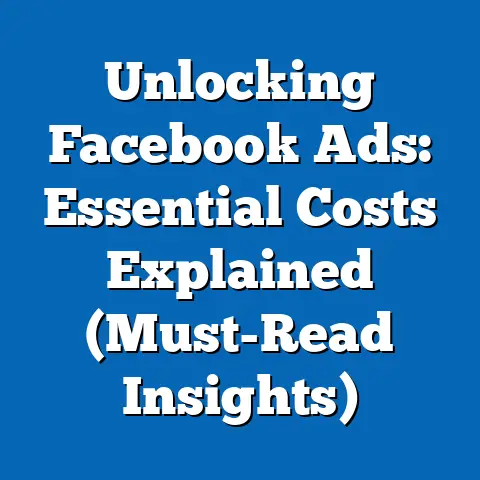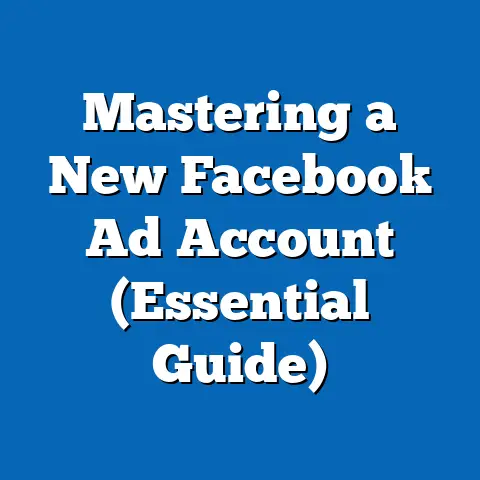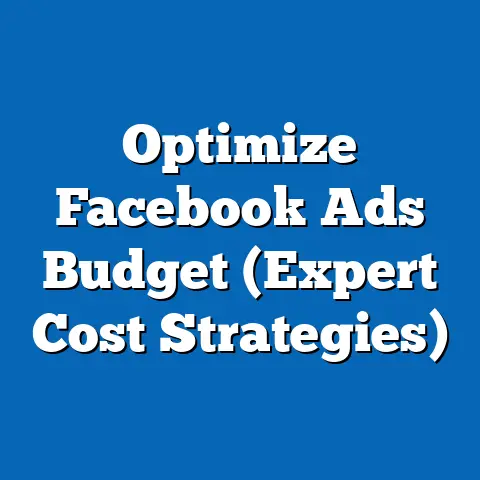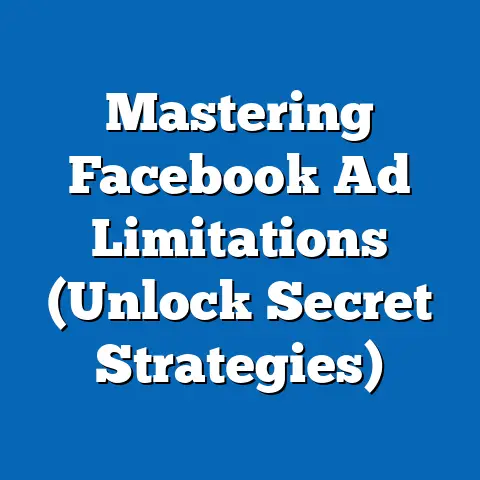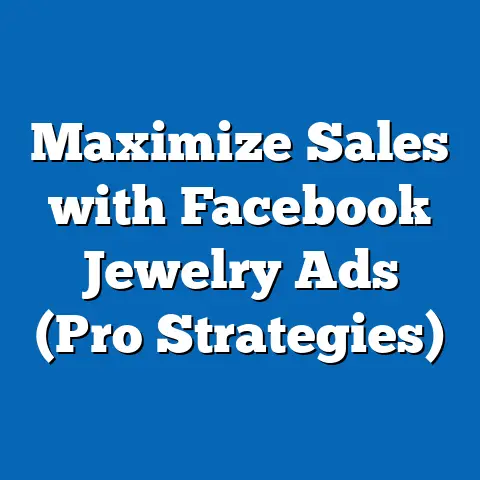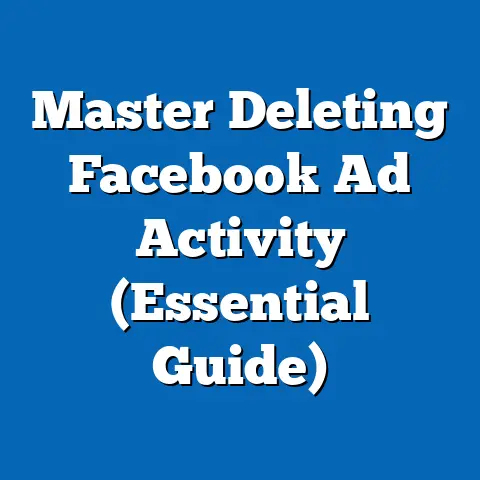Fix Facebook Ads Rejections (Proven Strategies Revealed)
It’s happened to the best of us. You spend hours crafting the perfect Facebook ad. You’ve meticulously chosen the images, painstakingly written the copy, and carefully selected your target audience. You hit submit, feeling confident and excited about the potential reach and engagement… only to receive that dreaded notification: “Your ad was rejected.”
My heart always sinks a little when I see that message. It’s frustrating, confusing, and frankly, a bit disheartening. You start questioning everything – was the image too provocative? Was the copy misleading? Did I somehow violate a policy I didn’t even know existed?
Believe me, you’re not alone. Thousands of advertisers face ad rejections every single day on Facebook. It’s a common challenge, but it doesn’t have to be a roadblock. The good news is that understanding the reasons behind these rejections and implementing proven strategies can significantly increase your chances of getting your ads approved and running successfully.
In this guide, I’m going to walk you through the ins and outs of Facebook’s ad review process, highlight common reasons for rejections, and provide actionable strategies to fix rejected ads and prevent future issues. Let’s turn those rejections into opportunities for learning and growth!
Understanding Facebook’s Ad Review Process
Before diving into the solutions, it’s essential to understand how Facebook reviews ads in the first place. It’s not just a random selection process – there’s a system in place.
Facebook’s ad review process is a multi-layered system that relies on both automated algorithms and human reviewers. When you submit an ad, it first goes through an automated review process. These algorithms are designed to quickly scan ads for potential violations of Facebook’s advertising policies and community standards. They look for things like:
- Prohibited Content: Explicit content, illegal products, hate speech, etc.
- Misleading Claims: False or exaggerated promises.
- Inappropriate Imagery: Sexually suggestive or violent images.
- Policy Violations: Anything that goes against Facebook’s advertising guidelines.
If the algorithm flags your ad, it may be rejected automatically. However, even if it passes the initial algorithmic check, it can still be reviewed by a human. This is where things get a bit more nuanced. Human reviewers can assess the context and intent of your ad, looking for subtle violations that an algorithm might miss.
Why is this process so strict?
Facebook prioritizes user experience and brand safety. They want to ensure that the ads people see are relevant, trustworthy, and don’t violate their community standards. A negative ad experience can damage Facebook’s reputation and lead to user attrition.
Key Takeaway: Facebook’s ad review process is a combination of automated and human checks designed to ensure ads comply with their policies and community standards. Understanding this process is the first step towards avoiding rejections.
Common Reasons for Rejections and How to Avoid Them
Knowing why ads get rejected is half the battle. Here are some of the most common culprits, along with practical tips to avoid them:
-
Misleading or False Content:
- Definition: This is a big one. Facebook prohibits ads that contain deceptive, false, or misleading claims. This includes exaggerated promises, unsubstantiated claims, and deceptive practices.
- Why it’s Important: Misleading ads erode trust and can lead to negative user experiences. Facebook is very strict about this.
- How to Avoid It:
- Be Truthful: Ensure all claims are accurate and can be substantiated.
- Avoid Exaggeration: Don’t overpromise or make claims that are too good to be true.
- Use Clear Language: Be clear and concise in your messaging. Avoid jargon or confusing language.
- Provide Evidence: If you’re making a specific claim, back it up with data or evidence.
- Example: Instead of saying “Lose 20 pounds in a week!” (which is likely false and misleading), try “Our program helps you achieve sustainable weight loss through balanced nutrition and exercise.”
-
Inappropriate Imagery:
-
Definition: This refers to images or videos that are sexually suggestive, violent, or otherwise offensive. It also includes images that exploit, abuse, or endanger children.
- Why it’s Important: Facebook wants to maintain a safe and respectful environment for its users. Inappropriate imagery can be harmful and offensive.
- How to Avoid It:
- Be Mindful of Visuals: Carefully consider the images and videos you use in your ads.
- Avoid Sexually Suggestive Content: Don’t use images that are overly revealing or suggestive.
- No Violence or Gore: Avoid images that depict violence, gore, or graphic content.
- Protect Children: Never use images that exploit, abuse, or endanger children.
- Example: Instead of using a close-up shot of a model in revealing clothing, try using an image that showcases the product in a positive and tasteful way.
-
Prohibited Content:
-
Definition: This is a broad category that includes content that is strictly prohibited by Facebook’s advertising policies. Examples include:
- Illegal products or services (drugs, weapons, etc.)
- Tobacco products and related paraphernalia
- Adult content and services
- Hate speech and discrimination
- Misinformation and conspiracy theories
- Why it’s Important: Facebook has a zero-tolerance policy for prohibited content. Violations can result in ad rejections, account suspensions, or even permanent bans.
- How to Avoid It:
- Know the Rules: Familiarize yourself with Facebook’s list of prohibited content.
- Avoid Sensitive Topics: Steer clear of controversial or sensitive topics that could be flagged.
- Be Responsible: Ensure your ads are not promoting illegal or harmful products or services.
- Example: Obviously, don’t advertise illegal drugs or weapons. But also be careful about promoting supplements with unproven claims or services that exploit vulnerable populations.
-
Inadequate Landing Pages:
-
Definition: Your landing page is the page users are directed to when they click on your ad. Facebook requires that your landing page be relevant to your ad, functional, and provide a positive user experience.
- Why it’s Important: A poor landing page can damage user trust and lead to high bounce rates. Facebook wants to ensure that users who click on ads are taken to a valuable and relevant destination.
- How to Avoid It:
- Relevance: Ensure your landing page content is directly related to your ad.
- Functionality: Make sure your landing page is working properly and loads quickly.
- User Experience: Provide a clear and easy-to-navigate experience.
- Transparency: Be transparent about your products, services, and pricing.
- Example: If your ad promotes a specific product, the landing page should be that product’s page, not just your homepage. Ensure the product is in stock and the page loads quickly.
-
Targeting Issues:
-
Definition: Facebook has specific rules about how you can target your ads. You cannot discriminate against users based on protected characteristics like race, ethnicity, religion, gender, sexual orientation, or disability.
- Why it’s Important: Facebook is committed to promoting equality and preventing discrimination. Discriminatory targeting can perpetuate harmful stereotypes and exclude certain groups from opportunities.
- How to Avoid It:
- Avoid Discrimination: Don’t target or exclude users based on protected characteristics.
- Use Broad Targeting: Consider using broad targeting options to reach a wider audience.
- Review Your Targeting: Carefully review your targeting settings to ensure they are not discriminatory.
- Example: Don’t target housing ads specifically to “English speakers only.” This could be seen as discriminatory against non-English speakers.
Misleading or False Content:
- Definition: This is a big one. Facebook prohibits ads that contain deceptive, false, or misleading claims. This includes exaggerated promises, unsubstantiated claims, and deceptive practices.
- Why it’s Important: Misleading ads erode trust and can lead to negative user experiences. Facebook is very strict about this.
- How to Avoid It:
- Be Truthful: Ensure all claims are accurate and can be substantiated.
- Avoid Exaggeration: Don’t overpromise or make claims that are too good to be true.
- Use Clear Language: Be clear and concise in your messaging. Avoid jargon or confusing language.
- Provide Evidence: If you’re making a specific claim, back it up with data or evidence.
- Example: Instead of saying “Lose 20 pounds in a week!” (which is likely false and misleading), try “Our program helps you achieve sustainable weight loss through balanced nutrition and exercise.”
-
Inappropriate Imagery:
-
Definition: This refers to images or videos that are sexually suggestive, violent, or otherwise offensive. It also includes images that exploit, abuse, or endanger children.
- Why it’s Important: Facebook wants to maintain a safe and respectful environment for its users. Inappropriate imagery can be harmful and offensive.
- How to Avoid It:
- Be Mindful of Visuals: Carefully consider the images and videos you use in your ads.
- Avoid Sexually Suggestive Content: Don’t use images that are overly revealing or suggestive.
- No Violence or Gore: Avoid images that depict violence, gore, or graphic content.
- Protect Children: Never use images that exploit, abuse, or endanger children.
- Example: Instead of using a close-up shot of a model in revealing clothing, try using an image that showcases the product in a positive and tasteful way.
-
Prohibited Content:
-
Definition: This is a broad category that includes content that is strictly prohibited by Facebook’s advertising policies. Examples include:
- Illegal products or services (drugs, weapons, etc.)
- Tobacco products and related paraphernalia
- Adult content and services
- Hate speech and discrimination
- Misinformation and conspiracy theories
- Why it’s Important: Facebook has a zero-tolerance policy for prohibited content. Violations can result in ad rejections, account suspensions, or even permanent bans.
- How to Avoid It:
- Know the Rules: Familiarize yourself with Facebook’s list of prohibited content.
- Avoid Sensitive Topics: Steer clear of controversial or sensitive topics that could be flagged.
- Be Responsible: Ensure your ads are not promoting illegal or harmful products or services.
- Example: Obviously, don’t advertise illegal drugs or weapons. But also be careful about promoting supplements with unproven claims or services that exploit vulnerable populations.
-
Inadequate Landing Pages:
-
Definition: Your landing page is the page users are directed to when they click on your ad. Facebook requires that your landing page be relevant to your ad, functional, and provide a positive user experience.
- Why it’s Important: A poor landing page can damage user trust and lead to high bounce rates. Facebook wants to ensure that users who click on ads are taken to a valuable and relevant destination.
- How to Avoid It:
- Relevance: Ensure your landing page content is directly related to your ad.
- Functionality: Make sure your landing page is working properly and loads quickly.
- User Experience: Provide a clear and easy-to-navigate experience.
- Transparency: Be transparent about your products, services, and pricing.
- Example: If your ad promotes a specific product, the landing page should be that product’s page, not just your homepage. Ensure the product is in stock and the page loads quickly.
-
Targeting Issues:
-
Definition: Facebook has specific rules about how you can target your ads. You cannot discriminate against users based on protected characteristics like race, ethnicity, religion, gender, sexual orientation, or disability.
- Why it’s Important: Facebook is committed to promoting equality and preventing discrimination. Discriminatory targeting can perpetuate harmful stereotypes and exclude certain groups from opportunities.
- How to Avoid It:
- Avoid Discrimination: Don’t target or exclude users based on protected characteristics.
- Use Broad Targeting: Consider using broad targeting options to reach a wider audience.
- Review Your Targeting: Carefully review your targeting settings to ensure they are not discriminatory.
- Example: Don’t target housing ads specifically to “English speakers only.” This could be seen as discriminatory against non-English speakers.
- Be Truthful: Ensure all claims are accurate and can be substantiated.
- Avoid Exaggeration: Don’t overpromise or make claims that are too good to be true.
- Use Clear Language: Be clear and concise in your messaging. Avoid jargon or confusing language.
- Provide Evidence: If you’re making a specific claim, back it up with data or evidence.
Inappropriate Imagery:
Definition: This refers to images or videos that are sexually suggestive, violent, or otherwise offensive. It also includes images that exploit, abuse, or endanger children.
- Be Mindful of Visuals: Carefully consider the images and videos you use in your ads.
- Avoid Sexually Suggestive Content: Don’t use images that are overly revealing or suggestive.
- No Violence or Gore: Avoid images that depict violence, gore, or graphic content.
- Protect Children: Never use images that exploit, abuse, or endanger children.
Prohibited Content:
Definition: This is a broad category that includes content that is strictly prohibited by Facebook’s advertising policies. Examples include:
- Illegal products or services (drugs, weapons, etc.)
- Tobacco products and related paraphernalia
- Adult content and services
- Hate speech and discrimination
- Misinformation and conspiracy theories
- Know the Rules: Familiarize yourself with Facebook’s list of prohibited content.
- Avoid Sensitive Topics: Steer clear of controversial or sensitive topics that could be flagged.
- Be Responsible: Ensure your ads are not promoting illegal or harmful products or services.
Inadequate Landing Pages:
Definition: Your landing page is the page users are directed to when they click on your ad. Facebook requires that your landing page be relevant to your ad, functional, and provide a positive user experience.
- Relevance: Ensure your landing page content is directly related to your ad.
- Functionality: Make sure your landing page is working properly and loads quickly.
- User Experience: Provide a clear and easy-to-navigate experience.
- Transparency: Be transparent about your products, services, and pricing.
Targeting Issues:
Definition: Facebook has specific rules about how you can target your ads. You cannot discriminate against users based on protected characteristics like race, ethnicity, religion, gender, sexual orientation, or disability.
- Avoid Discrimination: Don’t target or exclude users based on protected characteristics.
- Use Broad Targeting: Consider using broad targeting options to reach a wider audience.
- Review Your Targeting: Carefully review your targeting settings to ensure they are not discriminatory.
Key Takeaway: Understanding these common reasons for ad rejections and implementing the suggested tips can significantly reduce your chances of having your ads flagged.
Proven Strategies to Fix Rejected Ads
Okay, so your ad got rejected. Don’t panic! Here’s a step-by-step guide to fixing it:
-
Review the Rejection Notice:
- Location: The rejection notice will be in your Ads Manager. Look for a red notification bell icon.
- Understanding the Feedback: Carefully read the reason for the rejection. Facebook usually provides specific details about which policy was violated and why.
- Example: The notice might say: “Your ad was rejected because it violates our policy against promoting tobacco products.”
- Actionable Insight: Don’t just skim the notice. Understand the specific reason for the rejection. This is crucial for making the right adjustments.
-
Make Necessary Adjustments:
-
Content Revision: Based on the rejection notice, revise your ad copy, images, or videos.
- Landing Page Check: Ensure your landing page meets Facebook’s standards and is relevant to your ad.
- Targeting Review: Double-check your targeting settings to ensure they are not discriminatory or overly narrow.
- Checklist:
- Is the content truthful and accurate?
- Are the images appropriate and non-offensive?
- Does the landing page match the ad?
- Is the targeting non-discriminatory?
- Personal Story: I once had an ad rejected because I used the word “guaranteed” in the copy. Apparently, Facebook has strict rules about guarantees in certain industries. I removed the word and rephrased the sentence, and the ad was approved. It’s all about understanding the nuances of their policies.
-
Submit for Review:
-
Edit and Resubmit: Once you’ve made the necessary adjustments, edit your ad in Ads Manager and resubmit it for review.
- Appeal Option: In some cases, you may have the option to appeal the rejection. This is useful if you believe your ad was wrongly flagged.
- Be Patient: The review process can take some time. Don’t expect an immediate response.
- Pro Tip: If you’re unsure about why your ad was rejected, consider contacting Facebook Support for clarification before resubmitting. This can save you time and frustration.
Review the Rejection Notice:
- Location: The rejection notice will be in your Ads Manager. Look for a red notification bell icon.
- Understanding the Feedback: Carefully read the reason for the rejection. Facebook usually provides specific details about which policy was violated and why.
- Example: The notice might say: “Your ad was rejected because it violates our policy against promoting tobacco products.”
- Actionable Insight: Don’t just skim the notice. Understand the specific reason for the rejection. This is crucial for making the right adjustments.
-
Make Necessary Adjustments:
-
Content Revision: Based on the rejection notice, revise your ad copy, images, or videos.
- Landing Page Check: Ensure your landing page meets Facebook’s standards and is relevant to your ad.
- Targeting Review: Double-check your targeting settings to ensure they are not discriminatory or overly narrow.
- Checklist:
- Is the content truthful and accurate?
- Are the images appropriate and non-offensive?
- Does the landing page match the ad?
- Is the targeting non-discriminatory?
- Personal Story: I once had an ad rejected because I used the word “guaranteed” in the copy. Apparently, Facebook has strict rules about guarantees in certain industries. I removed the word and rephrased the sentence, and the ad was approved. It’s all about understanding the nuances of their policies.
-
Submit for Review:
-
Edit and Resubmit: Once you’ve made the necessary adjustments, edit your ad in Ads Manager and resubmit it for review.
- Appeal Option: In some cases, you may have the option to appeal the rejection. This is useful if you believe your ad was wrongly flagged.
- Be Patient: The review process can take some time. Don’t expect an immediate response.
- Pro Tip: If you’re unsure about why your ad was rejected, consider contacting Facebook Support for clarification before resubmitting. This can save you time and frustration.
Make Necessary Adjustments:
Content Revision: Based on the rejection notice, revise your ad copy, images, or videos.
- Is the content truthful and accurate?
- Are the images appropriate and non-offensive?
- Does the landing page match the ad?
- Is the targeting non-discriminatory?
Submit for Review:
Edit and Resubmit: Once you’ve made the necessary adjustments, edit your ad in Ads Manager and resubmit it for review.
Real-Life Example:
I worked with a local bakery that wanted to promote their new line of vegan cupcakes. Their initial ad was rejected because the image showed a close-up of a cupcake with a lot of frosting, which Facebook flagged as potentially promoting unhealthy eating habits.
To fix this, we changed the image to show a wider shot of the cupcakes alongside fresh fruit and other healthy ingredients. We also revised the copy to emphasize the vegan aspect and the use of natural ingredients. The ad was then approved and performed very well!
Key Takeaway: Fixing rejected ads requires careful review, targeted adjustments, and a willingness to learn from the feedback provided by Facebook.
Best Practices for Future Ad Campaigns
Prevention is always better than cure. Here are some proactive strategies to minimize the chances of future ad rejections:
-
Thoroughly Read Facebook’s Advertising Policies:
- The Source: Facebook’s advertising policies are available on their website.
- Stay Updated: These policies are constantly evolving, so it’s important to stay updated.
- Focus Areas: Pay close attention to sections on prohibited content, misleading claims, and targeting guidelines.
- Personal Anecdote: I make it a habit to review Facebook’s advertising policies at least once a quarter. It helps me stay ahead of the curve and avoid potential issues.
-
Test Ads Before Full Launch:
-
Small Budget: Run small-scale tests with a limited budget to gauge Facebook’s response to your ads.
- A/B Testing: Test different ad variations to see which ones are more likely to be approved.
- Early Feedback: This allows you to identify potential issues early on and make adjustments before investing heavily in a full campaign.
-
Utilize Facebook’s Ad Preview Tool:
-
Visualization: This tool allows you to preview how your ad will appear on different placements (e.g., Facebook feed, Instagram stories).
- Potential Issues: It can help you identify potential issues with your ad’s appearance, such as text that is cut off or images that are distorted.
- User Experience: This ensures your ad looks good and provides a positive user experience.
-
Engage with Facebook Support:
-
Clarification: If you’re unsure about whether your ad complies with Facebook’s policies, reach out to Facebook Support for clarification.
- Assistance: They can provide guidance and answer your questions.
- Peace of Mind: This can save you time and frustration in the long run.
Thoroughly Read Facebook’s Advertising Policies:
- The Source: Facebook’s advertising policies are available on their website.
- Stay Updated: These policies are constantly evolving, so it’s important to stay updated.
- Focus Areas: Pay close attention to sections on prohibited content, misleading claims, and targeting guidelines.
- Personal Anecdote: I make it a habit to review Facebook’s advertising policies at least once a quarter. It helps me stay ahead of the curve and avoid potential issues.
-
Test Ads Before Full Launch:
-
Small Budget: Run small-scale tests with a limited budget to gauge Facebook’s response to your ads.
- A/B Testing: Test different ad variations to see which ones are more likely to be approved.
- Early Feedback: This allows you to identify potential issues early on and make adjustments before investing heavily in a full campaign.
-
Utilize Facebook’s Ad Preview Tool:
-
Visualization: This tool allows you to preview how your ad will appear on different placements (e.g., Facebook feed, Instagram stories).
- Potential Issues: It can help you identify potential issues with your ad’s appearance, such as text that is cut off or images that are distorted.
- User Experience: This ensures your ad looks good and provides a positive user experience.
-
Engage with Facebook Support:
-
Clarification: If you’re unsure about whether your ad complies with Facebook’s policies, reach out to Facebook Support for clarification.
- Assistance: They can provide guidance and answer your questions.
- Peace of Mind: This can save you time and frustration in the long run.
Test Ads Before Full Launch:
Small Budget: Run small-scale tests with a limited budget to gauge Facebook’s response to your ads.
Utilize Facebook’s Ad Preview Tool:
Visualization: This tool allows you to preview how your ad will appear on different placements (e.g., Facebook feed, Instagram stories).
Engage with Facebook Support:
Clarification: If you’re unsure about whether your ad complies with Facebook’s policies, reach out to Facebook Support for clarification.
Key Takeaway: Proactive strategies like staying informed, testing ads, and engaging with Facebook Support can significantly reduce the likelihood of future ad rejections.
Tools and Resources for Managing Facebook Ads
Fortunately, you don’t have to navigate the Facebook advertising landscape alone. There are numerous tools and resources available to help you create compliant and effective ads:
-
Ad Management Platforms:
- Examples: Tools like Hootsuite Ads, AdEspresso, and Smartly.io can streamline ad creation, management, and reporting.
- Compliance Features: Some platforms offer features that help ensure your ads comply with Facebook’s policies.
- Efficiency: These platforms can save you time and effort.
-
Facebook’s Business Help Center:
-
Troubleshooting: This resource provides answers to common questions and troubleshooting tips.
- Learning: It also offers tutorials and guides on various aspects of Facebook advertising.
- Official Information: This is your go-to source for official information from Facebook.
-
Community Forums and Groups:
-
Networking: Connect with other advertisers in online forums and groups.
- Sharing: Share experiences, ask questions, and learn from others.
- Support: This can be a valuable source of support and inspiration.
Ad Management Platforms:
- Examples: Tools like Hootsuite Ads, AdEspresso, and Smartly.io can streamline ad creation, management, and reporting.
- Compliance Features: Some platforms offer features that help ensure your ads comply with Facebook’s policies.
- Efficiency: These platforms can save you time and effort.
-
Facebook’s Business Help Center:
-
Troubleshooting: This resource provides answers to common questions and troubleshooting tips.
- Learning: It also offers tutorials and guides on various aspects of Facebook advertising.
- Official Information: This is your go-to source for official information from Facebook.
-
Community Forums and Groups:
-
Networking: Connect with other advertisers in online forums and groups.
- Sharing: Share experiences, ask questions, and learn from others.
- Support: This can be a valuable source of support and inspiration.
Facebook’s Business Help Center:
Troubleshooting: This resource provides answers to common questions and troubleshooting tips.
Community Forums and Groups:
Networking: Connect with other advertisers in online forums and groups.
Key Takeaway: Leveraging the available tools and resources can make the Facebook advertising process easier and more effective.
Embracing the Challenge
Let’s face it: encountering ad rejections is an inevitable part of the Facebook advertising game. It can be frustrating, but it doesn’t have to be a setback. View these challenges as learning opportunities. Each rejection provides valuable feedback that can help you refine your ads and improve your overall strategy.
The key to success with Facebook ads is persistence, continuous learning, and adaptation. Stay informed about Facebook’s advertising policies, test different ad variations, and don’t be afraid to ask for help when you need it.
Remember that the goal is not just to get your ads approved, but to create ads that are effective, engaging, and provide value to your target audience. By focusing on these principles, you can turn those rejections into opportunities for growth and achieve your advertising goals on Facebook. So, take action, implement these strategies, and get those ads running! You got this!

